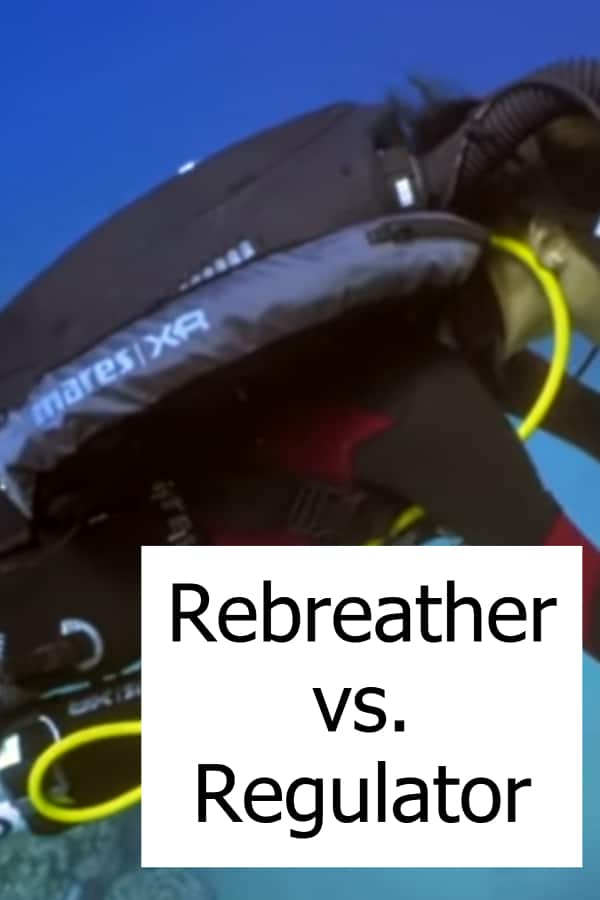Scuba Rebreather vs. Regulator – Ready to dive without Bubbles?
Whoever goes scuba diving uses a regulator to start out and for years to come. For a few years, there are also more and more rebreathers for rebreather diving hitting the market.
They are getting safer and more affordable. Yet, are they worth it? Why use one in the first place? How safe are they? Let’s have a look at scuba regulator vs rebreather to figure out the differences.
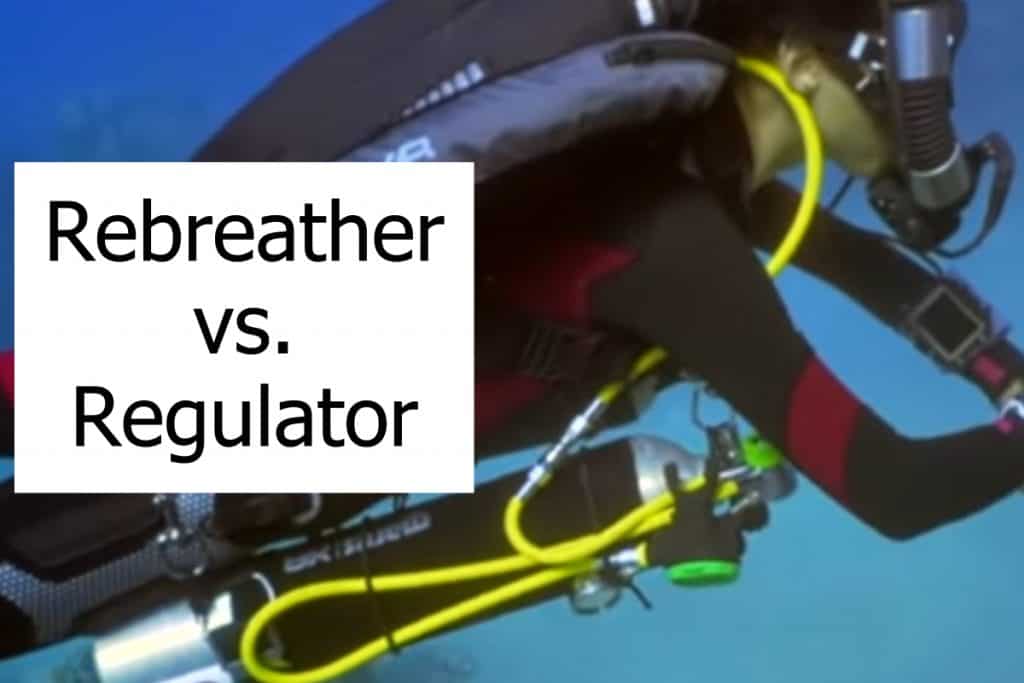
Every diver uses an open-circuit regulator. You go underwater, you breathe and the bubbles surround you. Not so with a rebreather. There are no bubbles and everything is quiet.
Eerie? Kind of…
So, besides the bubbles, what are the differences between a rebreather and a regulator? What are the pros and cons?
Let’s dive right into it!
What is a Rebreather for Scuba Diving?
A rebreather is a piece of scuba gear that allows you to breathe underwater using smaller gas tanks. It does this by recycling the gas you breathe over and over again. When you breathe in using a rebreather system when scuba diving, you’re getting your air from several different places.
First, the rebreather removes exhaled carbon dioxide from the gas mix you breathe out through the use of a canister of sodium hydroxide gas, termed a carbon dioxide scrubber. The two gases mixed to form a solid called calcium carbonate.
Closed-Circuit Rebreathers
Next, a small tank of pure oxygen or mixed gases (nitrogen and oxygen or helium and oxygen) will inject fresh gasses into your breathing loop in a closed-circuit diving rebreather system. This is called a fully closed-circuit breathing system because none of the gas ever leaves the system.
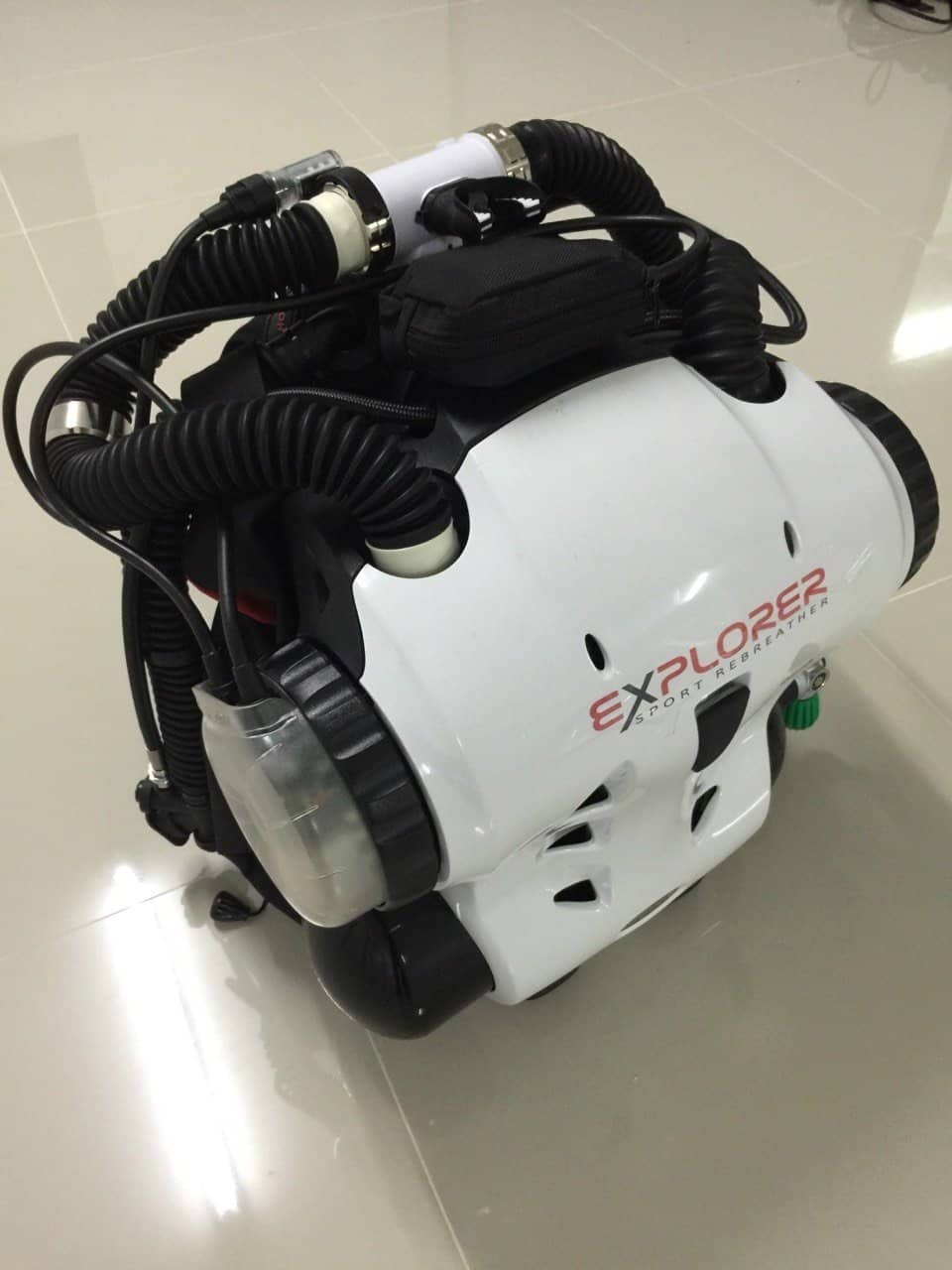
Balanced or Unbalanced Regulator? – What are the differences?
Closed-circuit rebreathers, as well as other types shown below, use computers and oxygen sensors to calculate and control a set point for the partial pressure of oxygen within the breathing circuit.
This information is sent through the control system and allows the rebreather to know how much oxygen or gas mix to deliver into the breathing loop.
Semi-Closed Circuit Rebreathers
These types of circuit systems are bulkier and simpler compared to fully closed-loop rebreathers. They reuse the gasses you breathe out and filter out some carbon dioxide.
Not all Air is Reused
The main difference is that they do not reuse all the gas. Some gas is released and substitued constantly with fresh breathing gas. That can be oxygen, nitrox, or trimix that is injected into the breathing loop.
Simpler Setup of a Partially Closed Breathing Gas Loop
The advantage is that such a partially closed system is much simpler in setup. In some cases, there’s not even a computer monitoring the gas and the partial pressure of oxygen in the system.
Fresh breathing gas is taken out of the gas supply continuously which makes this type of rebreather diving more affordable.
Potential Lack of Monitoring
Not having any monitoring of the breathing circuit and the gas that flows through it results in a higher risk of something going wrong. If you’re doing strenuous activities underwater, your body will require more oxygen.
Due to the lack of monitoring, the semi-closed loop cannot adjust the mix at any given time! Keep that in mind when you’re rebreather diving with a partially closed system without computer monitoring.
Can you Dive longer with a Rebreather?
Depending on the type of rebreather you have you can spend great lengths of time at depth. Completely closed-circuit rebreathers allow you to dive at greater depths for greater lengths of time because your gas is not pressure dependent.
If you are using an oxygen rebreather that carries only a cylinder of pure oxygen, you may be limited to no decompression stop depths.
Pros of a Closed-Circuit Rebreather
- Longer Dive Times
- Extended Bottom Time
- Silent
- Moist Warm Breathing Gas
Cons of a Closed-Circuit Rebreather
- Failures Can Go Unnoticed
- Higher Maintenance
- Higher Cost
When is a Rebreather Your Best Choice?
Open-Circuit rebreathers are typically used by divers who want to have greater dive times or spend more time at depth. They have been very popular with technical and professional divers for a long time.
Better Control of the Gas Mixture
Also, if you like to dive with gas mixes, a rebreather is going to be able to provide you with better control over those mixtures. Open-circuit rebreathers have superior computing capabilities for optimizing the gas mix.
What are the Differences between DIN vs. Yoke (A-Clamp) Regulators?
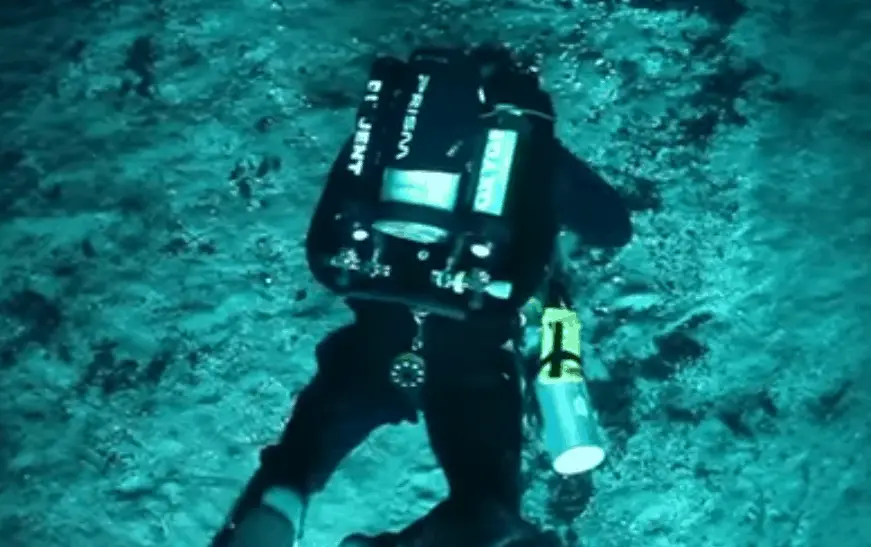
Underwater Photography without Bubbles
People who want to blend in with their environments seamlessly or be able to sneak up on a photography target may prefer a rebreather because it is not as loud as an open circuit regulator. The lack of bubbles makes rebreather’s very quiet.
Less Throat Irritation – Moist Air to Breathe
People who have throats that get very irritated with the dry gas of a regulator may be able to dive more comfortably with the rebreather because of the moist warm gas mix that rebreathers provide. The recirculated breathing gas is completely different than the type of gas you get from a regulator.
Why are Rebreathers Dangerous?
A rebreather system is not inherently dangerous when diving. They are actually quite safe.
The notion of them being a potential safety risk comes from the fact that there’s no backup. When there’s any malfunction, then there’s no alternative gas source.
Backup Plan when diving with a Regulator
If the computer does the calculations wrong and the carbon dioxide increases gradually in the loop then there’s no early warning. An open-circuit diving system/regulator breaks and you can switch to using the octopus of your dive buddy or use your Spare Air or pony bottle to safely return to the surface.
There’s no such ‘Plan B’ when you use a rebreather for diving. If it fails during a scuba dive, then the consequences can be fatal.
What is a Regulator?
The regulator of your scuba gear is directly attached to your dive tank through a high-pressure hose. This means every time you take a breath from your regulator, you get a lungful of gas directly from your tank.
Open Circuit Scuba Breathing System
When you breathe out the gas, including the carbon dioxide, is exhaled and goes through the regulator into the water in the form of bubbles. This is what divers call an open circuit diving system.
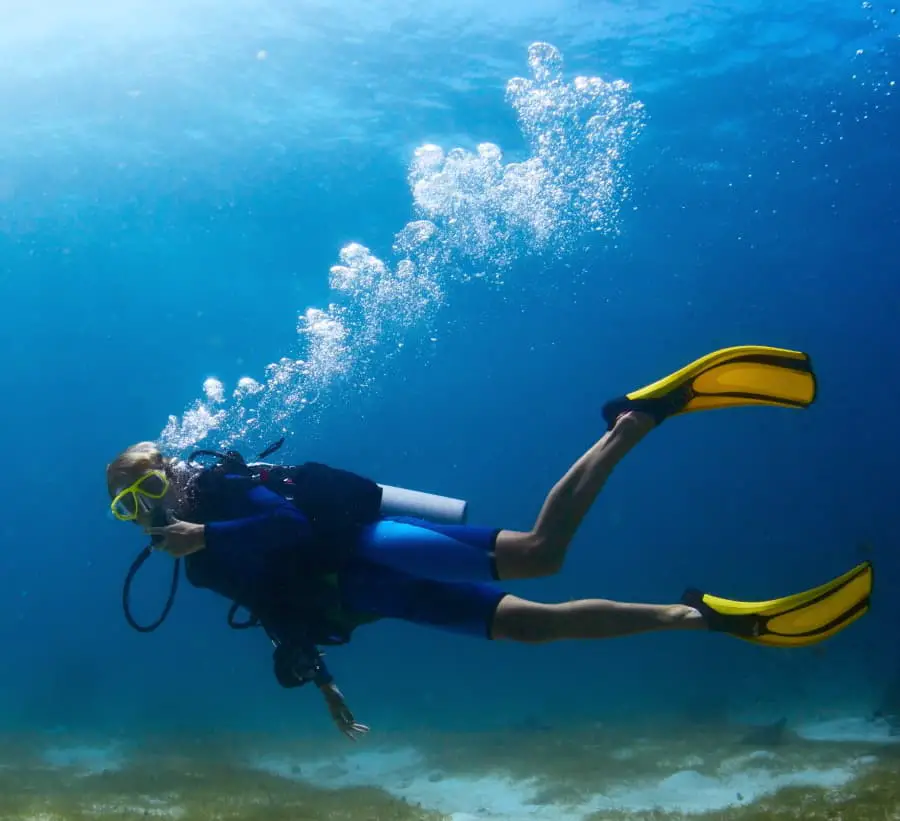
Best Scuba Regulators for Cold Water – Buyers Guide and Reviews
Always Fresh Air to Breathe – No Recycling
None of the gasses that you breathe when using a regulator is recycled. You breathe in the fresh gas every single time you take a breath and exhale it directly into the water.
You won’t breathe in any carbon dioxide you might have exhaled back into a closed-circuit diving system if you use an open-circuit diving regulator.
This means you have a set amount of gas to use in such an open-circuit system. Once the amount of gasses you filled up in your tank is gone, it’s gone, and you have no way of refilling it until you surface.
Pros of Using an Open-Circuit Diving Regulator
- You can use a backup
- Fresh breathing gas every time
- Simple to use
- Require less maintenance
Cons of an Open-Circuit Diving Regulator
- Bottom Time Limited
- The gas you breathe is pressure dependent
- Less accurate gas mix control
When should you choose a Scuba Regulator?
Regulators are ideal for people who are just getting into diving. Chances are you’re not looking for the most expensive equipment. You’re not going to be diving at great depths. And you’re not going to be diving with technical gas mixes.
Less Chance of a Disastrous Malfunction
People who like to have a backup plan are going to be much more comfortable using an open-circuit regulator system then they are using a rebreather. When a rebreather brakes down at depth, it can be a life-ending event.
Backup options with a Regulator Compared to a Rebreather
However, if your regulator breaks down at depth, you will likely have your spare on hand, or you can share it with your dive buddy. If you’re a person, who values redundancies for safety reasons you definitely want to use a regulator over a rebreather.
Dry Air Tastes Better for Some
Some people don’t like the way that the rebreather’s breathing gas tastes. While it is warmer and moister, it can taste quite different than the gasses you get off the regulator. This is a personal choice, but it may be one that makes or breaks whether or not you get a regulator or rebreather.
Comparing Diaphragm vs Piston Regulator – What makes them different?
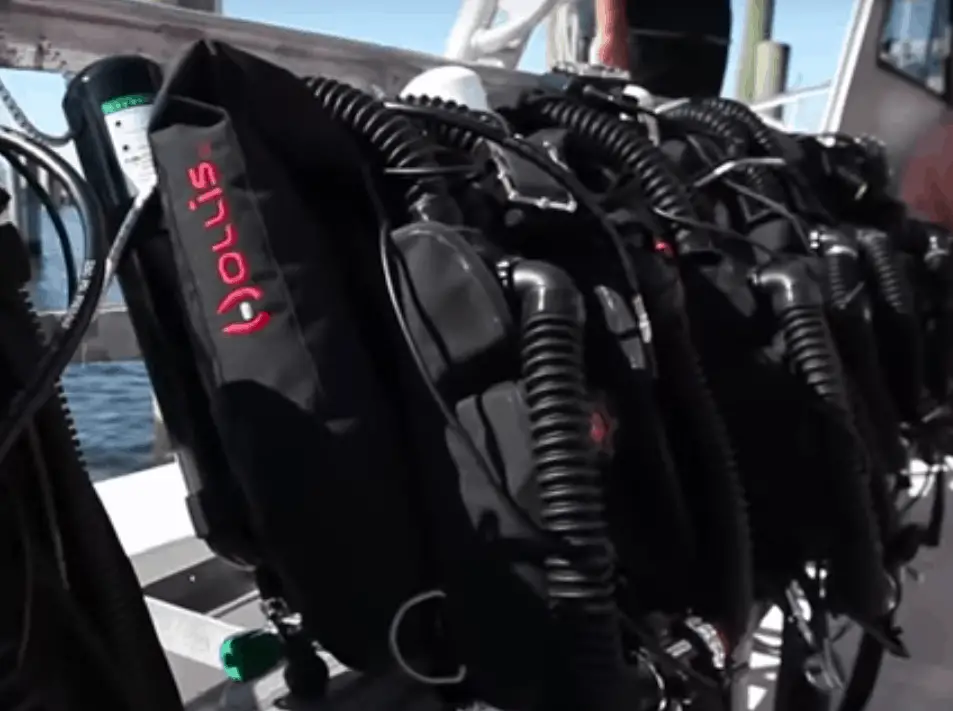
What are the differences? – Scuba Regulator vs Rebreather
Regulators and rebreathers are completely different systems. Aside from the fact that they both allow you to breathe underwater, they have very little in common.
What Air do you Breathe?
A regulator will give you fresh gasses every breath you take but provides you with minimal bottom time. The rebreather gives you maximum bottom time, but you don’t get that same fresh gas mix.
The air you exhale gets recycled to allow the closed-circuit diving system to remove carbon dioxide from your exhaled breath. In an open-circuit system, your exhaled gas mix simply gets out into the water.
Cost and Maintenance
There are also differences in cost and maintenance. A regulator requires less maintenance than a rebreather, it costs less, and if it fails; it is less life-threatening. While both systems are great, you will have to decide for yourself which one is best to use.
Closed-circuit rebreather systems are technically a lot more sophisticated and contain more parts as part of the breathing apparatus. Maintenance requirements are more complex and broken parts can be a lot more expensive.
Closed-circuit diving requires replenishable items like the carbon dioxide scrubber and the oxygen, nitrox, or trimix tanks that can also end up at least as or even more expensive than a regulator and tank setup.
Other parts that might break, like the oxygen sensors can make it more expensive for rebreather divers to enjoy the wonders underwater.
Share It!
Can we ask for a favor? Could you please use the image below to share the Scuba Regulator vs Rebreather information on social media? We appreciate your support!
